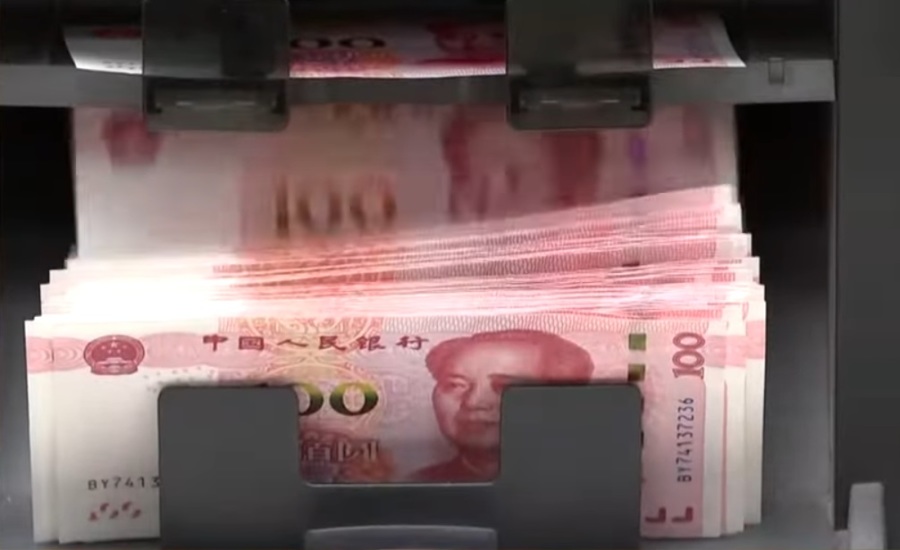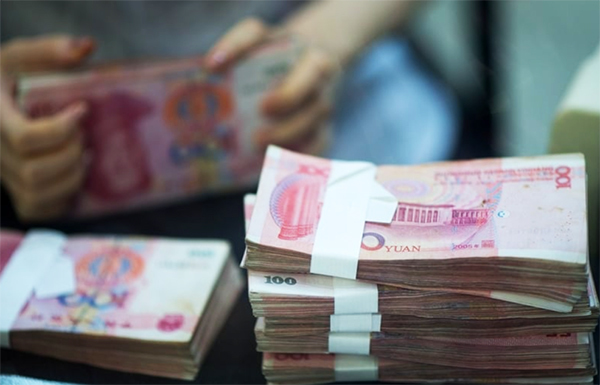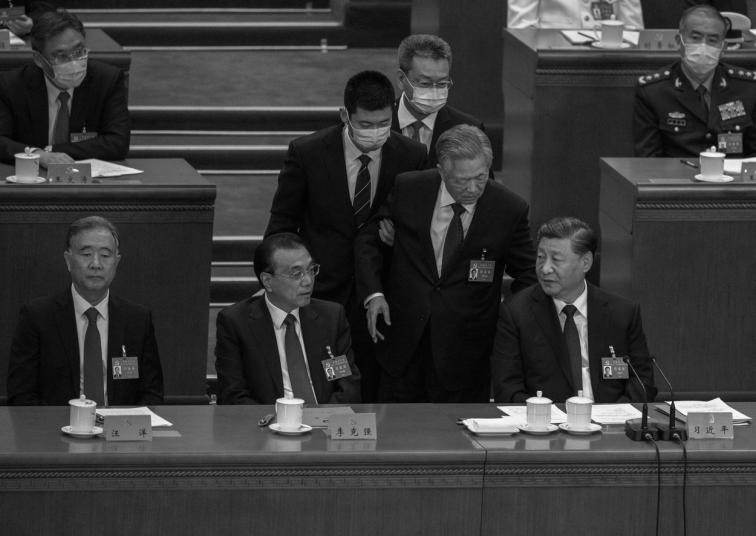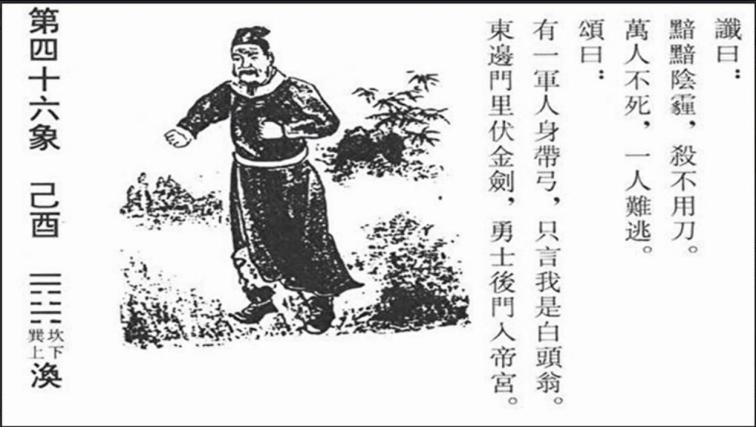A photo of Renminbi
[People News] According to data from the Ministry of Finance, by the end of September 2025, the national local government debt balance had surged to 53.6995 trillion yuan, a 20% increase from the same period last year. The International Monetary Fund (IMF) estimates that if hidden debts are included, China’s overall government debt-to-GDP ratio could reach as high as 96.3%.
Over decades of CCP “reform and opening,” local governments, in pursuit of GDP growth and officials chasing political achievements, borrowed wildly for infrastructure and investment. As asset bubbles grew, debts snowballed. This has exposed severe fiscal imbalances and the ongoing tug-of-war between central and local governments over revenue and authority. Local government debt in the CCP has become an intractable burden—a ticking time bomb buried in the entire economic system amid the current downturn.
For political stability, the central government has rolled out a series of measures to underwrite and resolve debts, but due to the bleak economic fundamentals, the results have been minimal. In the first 10 months of 2025, local bond issuance reached approximately 9.1 trillion yuan, up 23% year-on-year. Of this, new local government bonds issued were about 4.7 trillion yuan (up ~2%), and refinancing bonds were 4.4 trillion yuan (up ~58%). Refinancing bonds are essentially used to “borrow new to repay old” and to replace existing hidden local government debts.
The explosive growth of local debt has made the “Party Mom” anxious—how much longer can this go on? How much more money must be poured into this bottomless pit?!
Central-Local Mistrust: Ministry of Finance Establishes Debt Management Department
On November 3, 2025, the CCP officially announced that the Ministry of Finance had established the Debt Management Department, with six divisions: Comprehensive Division, Central Debt Division, Local Debt Division I, Local Debt Division II, Issuance and Redemption Division, and Monitoring and Management Division. It consolidates all powers—from formulating debt management policies and setting quotas, to supervising bond issuance and redemption, risk warnings, and emergency handling. Previously scattered functions across the Budget Department and Treasury Department are now unified under “three-debt unified management” for national bonds, local bonds, and foreign debt.
In the past, local government debt management was split into “three powers”: the Ministry of Finance handled local bond issuance, the NDRC approved corporate bonds, and the CBIRC managed bank credit. This fragmented, “nine dragons managing the water” model easily bred debt risks. The Debt Management Department now exercises full oversight—from bond issuance approval to fund usage tracking, from debt risk assessment to default contingency plans—forming a centralized mechanism with no blind spots in power. Mainland media reported that the department will focus on monitoring hidden debts formed through local government financing vehicles (LGFVs), PPP projects, and other channels.
After the 1994 tax-sharing reform, local and central finances were separated, but generally, locals had little money and many responsibilities, while the center had more money and fewer duties. The CCP allowed locals to sell land for revenue, so local governments set up LGFVs to leverage debt. Land finance and GDP soared, but so did massive hidden debts. Now, with the economy rapidly declining and real estate collapsing, the hidden debt crisis is erupting. The Party Mom is in a bind—manage it or not? The establishment of the Debt Management Department reflects the center’s helplessness at being dragged down by local debts. Local finances not only rely on central transfer payments, forming a habit of “reaching out for money,” but likely also involve underreporting debts to the Ministry of Finance. Even with deep pockets, the center cannot withstand such long-term, bottomless consumption.
At the 12th meeting of the 14th NPC Standing Committee on November 8, 2024, the CCP announced a 12 trillion yuan debt resolution plan. Under the plan, by 2028, the total hidden debt that local governments need to resolve would drop from 14.3 trillion yuan to 2.3 trillion yuan. But the CCP knows full well that the true scale of local hidden debt far exceeds 14.3 trillion.
At the Central Economic Work Conference in November 2024, the CCP set the tone for 2025 to implement a “more proactive fiscal policy.” The central fiscal deficit-to-GDP ratio for 2025 may rise to 4.0%, with a new fiscal deficit of 5.2 trillion yuan and the sum of local special bonds and special treasury bonds approaching 13 trillion yuan—roughly 9–10% of 2025 GDP. Such a scale of broad deficit is rare in history.
From an institutional perspective, the Debt Management Department’s creation aims to prevent local debt risks through a unified policy framework, signaling the open escalation of the central-local game in debt governance. Locals naturally want to borrow more and have the center clean up and increase transfers. The Party Mom has decided that from now on, there will be no more “blind love”—no more giving milk to whoever cries loudest. Now, it depends on how much you borrow and how big your debt hole is. If the hole is too big, you have to fill it yourself.
Sure enough, some provinces, reading the higher-ups’ intent, came up with rotten ideas—expertly fleecing the wool, shamelessly and immorally.
Hubei’s “Three-izations” Professional Dirty Trick; Northeast’s “Turning Mud into Gold” Debt Resolution
In October 2025, Hubei launched a state-owned “three capital” reform policy: “Assetize all state-owned resources as much as possible, securitize all state-owned assets as much as possible, and leverage all state-owned funds as much as possible.” It scientifically uses four methods—“use if possible, sell if not used, rent if not sold, finance if possible”—to revitalize assets. Anhui, Jilin, Heilongjiang, and others quickly followed suit. The policy sounds professional and grand, but it’s really just desperate local governments with no rice in the pot, packaging broken bricks and tiles as gold mountains, slapping on asset labels to sell, then leveraging bank loans and even going public to siphon stock market funds—a government-led Ponzi scheme.
This playbook reached its peak in Qiqihar. In Yi’an County, Qiqihar City, the 11 million cubic meters of silt at the bottom of the Shangyou and Yuejin Reservoirs were sold for a sky-high 839 million yuan to Qiqihar Zeyuan Environmental Industry Co., Ltd. for 20-year disposal rights.
Even more bizarre: the company is a state-owned sole proprietorship established on October 10, 2025, with registered capital of 270 million yuan. Spending 800 million on a pile of rotten mud—are they insane? It wouldn’t pay back in a century. A few years ago, cash-strapped Sichuan auctioned off cafeteria operation rights for primary and secondary schools for the next 20 years; Guizhou packaged and sold roadside parking spaces for the next 30 years. This time, they’re directly selling mud—turning mud into gold.
Where does the 800 million come from? Simple: pledge future revenue rights to banks for an 800 million loan. The government is short on cash and can’t directly borrow from banks to pay civil servants, so they pull a magic trick. The real game isn’t digging mud offline but financing online. The left hand holds assets, the right hand capital—what the silt in the middle is hardly matters anymore. What about bank bad debts? What if the bank collapses? Package it to state asset management companies, issue more bonds, inject capital, and revive—as long as it’s under the state-owned banner, there’s no shortage of fools to take it. As for depositors—stability maintenance.
Netizens saw through it instantly and gave professional breakdowns: “Three capital” jargon translated to plain speech: register that crooked-neck tree in your backyard as an “ecological asset with ornamental value and potential carbon sink function,” get a professional appraiser to value its fruits for 30 years, package it into a “revenue rights certificate” and sell it, cash out, then leverage a bank loan to buy 100 more crooked-neck trees, and pry open the capital market—magical cycle.
This routine has long been played in financial and capital circles; now the protagonist is just switched to local governments, all to resolve debt. What is debt resolution? A netizen’s brilliant metaphor: You tell your boss, “I don’t want wages for the next 20 years—just give me 30% of it all at once now.” The boss lights you a cigarette, cautiously and earnestly asks: “Did something happen to you?” Yes—that’s debt resolution.
Fiscal Shortfalls: Local Governments Innovate in Fleecing
In 2025, civil servants and public institution staff in many provinces faced salary adjustments or arrears. The traditional “iron rice bowl” is rapidly eroding. According to Radio Free Asia, civil servants, teachers, doctors, and others in economically developed areas like Beijing, Zhejiang, Shandong, and Guangdong have seen pay cuts.
X platform account “Teacher Li Is Not Your Teacher” recently posted that on November 1, a regime insider in Zaozhuang City, Shandong Province, asked online when wages would be paid. The comment section was flooded with people saying they’d been owed wages for months—some six, some eight.
State-owned enterprises delaying worker wages is commonplace. On November 1, workers from China Construction Third Engineering Bureau in Qingdao, Shandong, protested long-term wage arrears, demanding settlement. On November 2, workers accused Zhufeng Labor Service Company on a China Construction Eighth Engineering Bureau project in Shanghai of owing wages and refusing to acknowledge it. The same day, Tianjin’s Zhihongquan Company was exposed for owing wages, with workers collectively demanding payment. Henan’s Yuzhou Shenhuo Kuanfa Mining Co., Ltd. was also complained about by workers for wage arrears, who spontaneously went to the company to demand payment.
Meanwhile, the CCP government is finding every way to harvest leeks and fleece wool, constantly innovating methods: raising or disguised raising prices for water, electricity, and fuel basic public resources; implementing universal social security and increasing contribution bases; levying property taxes; collecting individual taxes from crowd-sourced delivery workers; implementing new VAT clauses from November 1, increasing corporate tax burdens; far-sea fishing for private enterprises; arbitrary fines—2024 saw nearly 100 publicly fined listed companies, each facing millions in penalties. A market supervision enforcer in Chengwu County, Shandong, bluntly said, “Bankrupting a company is too easy,” and “we have 50 million yuan in (fine) political achievements annually.” Netizens posted about being fined for drinking while cycling or not wearing seatbelts in the back seat. Though these methods can fill gaps short-term, they are like drinking poison to quench thirst, intensifying official-public confrontation, exacerbating social conflicts, and worsening the economic downturn.
Local Debt Noose Tightens: Incurable Burden
Despite the CCP’s repeated claims that government debt ratios are within international warning lines and controllable, international rating agencies, investment banks, and mainstream media disagree.
In December 2024, Moody’s estimated total CCP local government debt at 90–110 trillion yuan, with hidden debt (LGFV) at 50–65 trillion, assessing that local debt pressure is “continuously worsening.” Land finance revenue in many areas has plummeted, repayment capacity weakened, and hidden debt risks are transmitting to the banking system, leading Moody’s to downgrade China’s sovereign credit outlook to negative.
S&P Global’s 2025 outlook report shows CCP local total debt at ~95–105 trillion yuan, or 80%–85% of GDP, with 55–60 trillion in hidden debt. Real estate downturn caused land transfer income to drop 20–30% on average; local governments may need 10–20 years to resolve debts.
According to Fitch Ratings’ analysis and forecast, China’s explicit central and local government debt will rise to 68.3% of GDP in 2025 (from 60.9% in 2024) and further to 74.2% in 2026, with total debt estimated at ~96 trillion yuan. Fitch considers “augmented debt” (explicit + LGFV hidden) at 124% of GDP in 2024. In 2025, due to debt swaps, augmented debt may stay at 125%–130% of GDP, totaling ~176–183 trillion yuan, with local government portion ~110–120 trillion yuan. Fitch analyzes that the 2025 general public deficit is expected to rise to 8.4% of GDP (from 6.5% in 2024).
China’s local government debt crisis is a chronic systemic disease. Land finance once accounted for 40% of local revenue, but after the real estate market collapsed, income was halved, triggering a debt avalanche. The CCP’s soft budget constraints plus implicit guarantees let debt balloon like a gas-filled balloon. Under this pressure, local governments must repay debts while maintaining public spending. Most critically, wages for regime insiders, high social security, pensions, and medical insurance are enormous. The pay-as-you-go mechanism is insufficient to cover deficits, forcing cuts to other public spending—even stability maintenance funds are short. Truly an incurable burden.
(People News first release) △











News magazine bootstrap themes!
I like this themes, fast loading and look profesional
Thank you Carlos!
You're welcome!
Please support me with give positive rating!
Yes Sure!